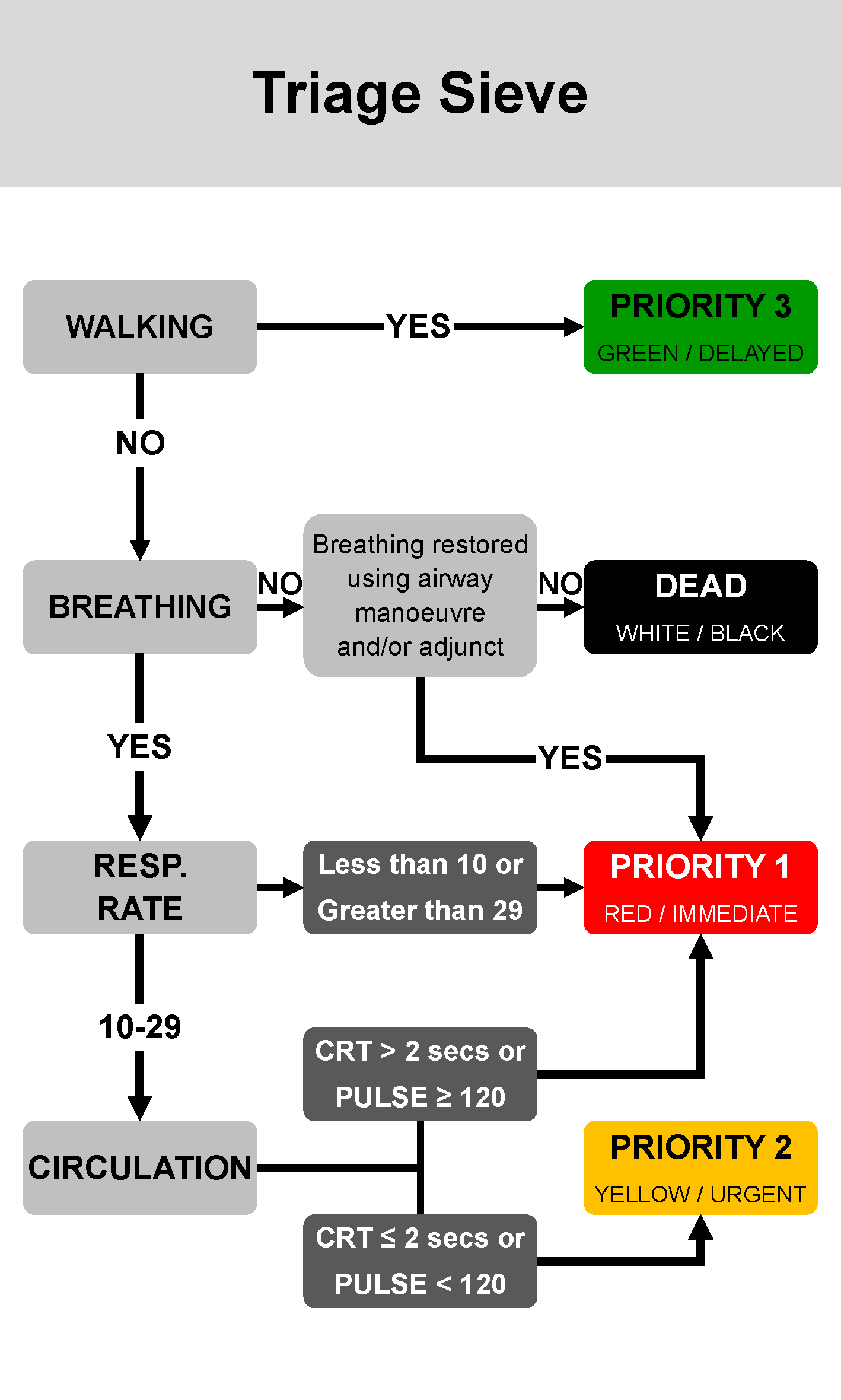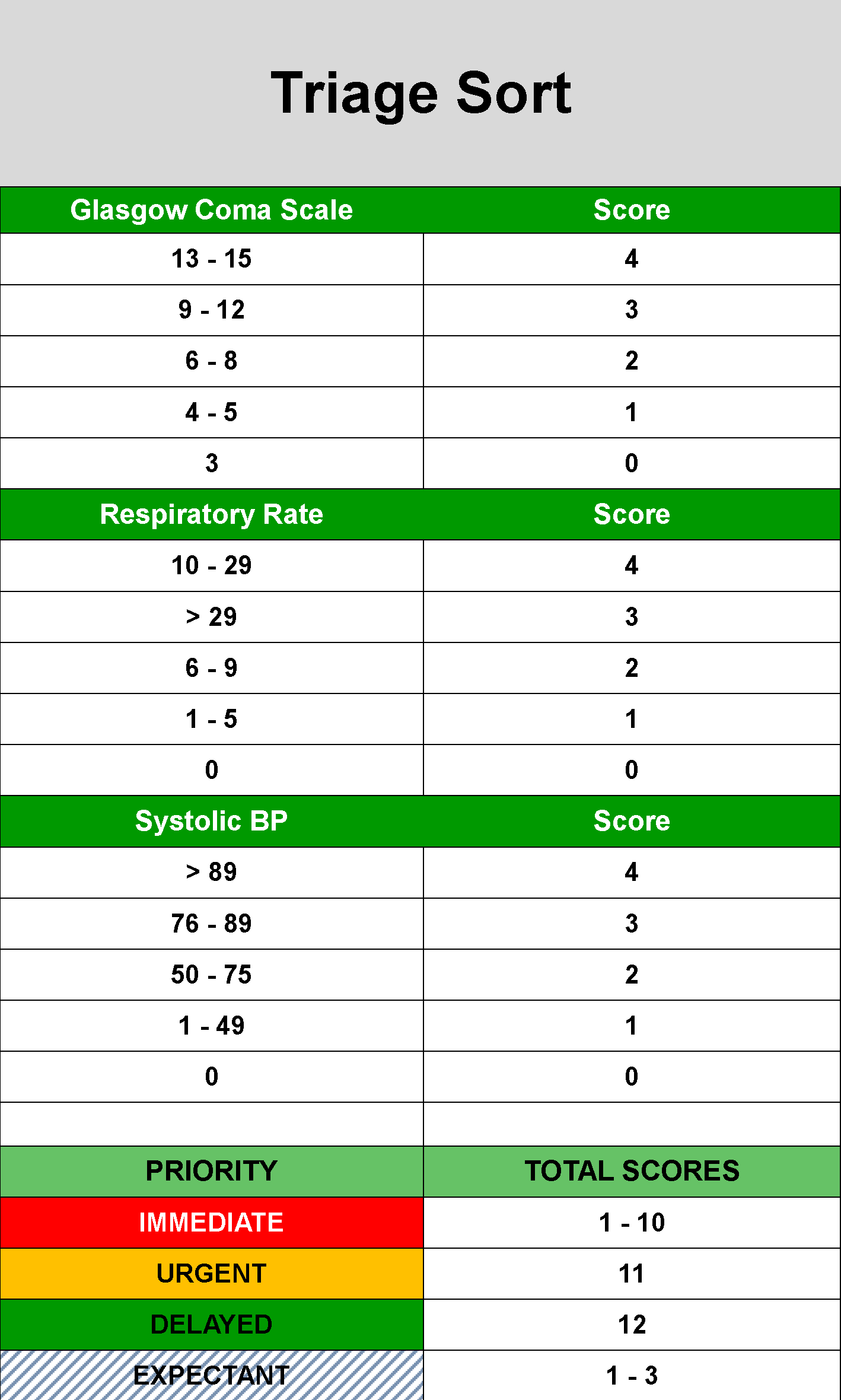
Three phases of major incident:
Triage » Treatment » Transport
Do not progress with in-depth treatment until all SIEVE triaging is complete.
KEY CONSIDERATIONS
- Appropriate tabard and PPE must be worn
- Initial treatment should consist of life-saving interventions only:
- Open airway
- Lateral patient position if possible
- Control life-threatening bleeding
- Maintain documentation
- SMART Tags
- PCRs
- Incident book
- Scene safety assessment: Do not enter/proceed into scene until deemed safe.
- Provide METHANE to State Operations Centre (SOC)
- Major Incident Confirmed
- Exact Location
- Type of Incident
- Hazards Present
- Access
- Number and type of casualties
- Emergency Services present/required
- Assume Acting Ambulance Commander & Forward Commander Roles
- Establish on scene liaison with other agencies
- Maintain communications with SOC
- Establish Ambulance Assembly Point (AAP) & Casualty Clearing Post (CCP)
- Consider need for Mass Casualty Kits (MCKs) and/or Emergency Support Vehicles (ESV)
Report to Ambulance Commander
- Park vehicles at AAP & leave keys in vehicle
- Undertake the role delegated by the Ambulance Commander
- Use equipment/consumables from ESVs & MCKs if available
- Use radio channel designated for incident
- Maintain incident chain of command
Obtain SITREP & establish the following:
- Maintain incident documentation
- Establish command & communication structure
- Confirm setup of AAP & CCP
- Ensure availability of hand held radios
- Ensure safety of all ambulance personnel
Continue to:
- Liaise with HMA Incident Controller & other agency commanders
- Liaise with SOC & other key field staff
- Direct Hospital Response Teams (HRTs) to Health Commander
- Monitor adequacy of ambulance resources
Reports to Ambulance Commander.
Appointed once adequate incident resources are available.
- May begin initial Triage SIEVE until more resources become available
- Take responsibility for forward operational activities
- Ensure casualty Triage SIEVE & labelling undertaken using SMART tags
Reports to Forward Commander.
Designated if size of scene requires incident to be sectored for ease of management.
- Supervise Primary Triage Officers ensuring Triage SIEVE activities are undertaken
- Direct walking wounded to CCP
- Supervise necessary treatment before the CCP
- Report ‘Triage SIEVE’ as required
- Assist the Casualty Clearing Officer once Hot Zone/Extrication Point cleared of casualties
Officer must:
- Obtain SMART Triage Pac; place on uniform belt
- Triage each casualty and attach SMART Tag to CASUALTY’S RIGHT ARM
- Only provide treatment consisting of body positioning, opening airways & stopping life-threatening bleeds
- Maintain a written record of each casualty triaged on the back of the SMART Tag
Reports to Ambulance Commander:
- Appoint Loading Officer
- Supervise setting up and running of CCP
- Appoint staff to undertake SORT Triage
- Ensure SORT casualty log is maintained
- Liaise with Senior Doctor & Senior Nurse if Hospital Response Teams (HRTs) present
- Liaise with other key field staff
Reports to Casualty Clearing Officer:
- Checks all casualties correctly SMART Tagged
- Maintain casualty Transport Log Sheets
- Supervise casualty transfer from loading area to ambulance
- Liaise with Transport Nurse if Hospital Response Teams (HRTs) present
- Take direction from SOC or the Department of Health on casualty destinations
Transport Considerations
- Triage priority
- Treatment and packaging
- Appropriate destination
Reports to Ambulance Commander:
- Check Access/Egress routes established
Meet arriving ambulance crews and direct incoming staff to Ambulance Commander or delegated person, ensuring that arriving crews have:
- Left keys in vehicles
- Appropriate tabards & PPE on
- Parked vehicles orderly & all lights turned off
- Taken appropriate equipment into the scene
Key Terms & Links
Document Control
Clinical Resources Website
St John Ambulance Western Australia Ltd (ABN 55 028 468 715) (St John WA) operates ambulance and other pre-hospital clinical services. St John WA’s Clinical Resources, including its Clinical Practice Guidelines (Clinical Resources), are intended for use by credentialed St John WA staff and volunteers when providing clinical care to patients for or on behalf of St John WA, within the St John WA Clinical Governance Framework, and only to the extent of the clinician’s authority to practice.
Other users – Terms of Use
The content of the St John WA Clinical Resources is provided for information purposes only and is not intended to serve as health, medical or treatment advice. Any user of this website agrees to be bound by these Terms of Use in their use of the Clinical Resources.
St John WA does not represent or warrant (whether express, implied, statutory, or otherwise) that the content of the Clinical Resources is accurate, reliable, up-to-date, complete or that the information contained is suitable for your needs or for any particular purpose. You are responsible for assessing whether the information is accurate, reliable, up-to-date, authentic, relevant, or complete and where appropriate, seek independent professional advice.
St John WA expressly prohibits use of these Clinical Resources to guide clinical care of patients by organisations external to St John WA, except where these organisations have been directly engaged by St John WA to provide services. Any use of the Clinical Resources, with St John WA approval, must attribute St John WA as the creator of the Clinical Resources and include the copyright notice and (where reasonably practicable) provide a URL/hyperlink to the St John WA Clinical Resources website.
No permission or licence is granted to reproduce, make commercial use of, adapt, modify or create derivative works from these Clinical Resources. For permissions beyond the scope of these Terms of Use, including a commercial licence, please contact medservices@stjohnambulance.com.au
Where links are provided to resources on external websites, St John WA:
- Gives no assurances about the quality, accuracy or relevance of material on any linked site;
- Accepts no legal responsibility regarding the accuracy and reliability of external material; and
- Does not endorse any material, associated organisation, product or service on other sites.
Your use of any external website is governed by the terms of that website, including any authorisation, requirement or licence for use of the material on that website.
To the maximum extent permitted by law, St John WA excludes liability (including liability in negligence) for any direct, special, indirect, incidental, consequential, punitive, exemplary or other loss, cost, damage or expense arising out of, or in connection with, use or reliance on the Clinical Resources (including without limitation any interference with or damage to a user’s computer, device, software or data occurring in connection with such use).
Cookies
Please read this cookie policy carefully before using Clinical Resources from St John WA.
The cookies used on this site are small and completely anonymous pieces of information and are stored on your computer or mobile device. The data that the cookies contain identify your user preferences (such as your preferred text size, scope / skill level preference and Colour Assist mode, among other user settings) so that they can be recalled the next time that you visit a page within Clinical Resources. These cookies are necessary to offer you the best and most efficient possible experience when accessing and navigating through our website and using its features. These cookies do not collect or send analytical information back to St John WA.
Clinical Resources does integrate with Google Analytics and any cookies associated with this service enable us (and third-party services) to collect aggregated data for statistical purposes on how our visitors use this website. These cookies do not contain personal information such as names and email addresses and are used to help us improve your user experience of the website.
If you want to restrict or block the cookies that are set by our website, you can do so through your browser setting. Alternatively, you can visit www.internetcookies.com, which contains comprehensive information on how to do this on a wide variety of browsers and devices. You will find general information about cookies and details on how to delete cookies from your device. If you have any questions about this policy or our use of cookies, please contact us.


